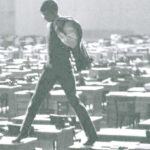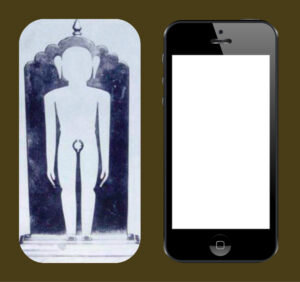
The Sublime Uselessness of Old-School Asana
October 18, 2016
Regulating Yoga Teachers? How About Regulating Yoga Cults, First?
October 29, 2016My kind host for a meditation weekend in Coeur d’Alene emailed ahead to ask about protocol for the weekend. One question was about mobile devices. The logistics part is simple, but the question also brings up a lot about what meditation might mean and engage with moving forward in our evolutionary storm.
Etiquette first: ringers and vibrate functions are best turned off for a weekend like this. Going further to block cell data would seem to be reasonable if you want to really internalize.
On the other hand, access to texting can put the mind of an anxious caregiver – for children or the elderly – at ease. And nobody would ask the on-call surgeon to turn their pager off.
For those willing to experiment, it’s interesting to see what limiting device usage on off hours contributes as well. Many people sense a serene envelope open up in time when they fast from data. Perhaps they remember the feeling of knowing something instead of being told something.
But for some – millenials especially – the prospect of going device-free for two and a half days is panicky. If we just chuckle about this – kids these days! – we risk brushing over the startling fact that the whole species is becoming cybernetic, and there’s no turning back, and our spirituality has to accommodate this fact if it is going to avoid exercising a pious and/or regressive nostalgia.
Beneath the discussion of best practices lie our feelings about the devices themselves, their distracting impact on our lives, and their seeming incompatibility with introspection in general, let alone in relation to meditation. What’s complicated is that we feel their positive effects as well. We’ve felt ourselves judiciously use devices to self-regulate, even contemplate, recover from extroversion, to reach out of loneliness for something that feels like contact, and might actually be good enough at times. We should remember that the original “text neck” was the head bowed constantly in prayer and deference.
In meditation environments that owe their moods and aesthetics to earlier times, the impacts of devices are viewed as so foreign and intrusive that some facilitators braid their pre-modern instructions with a penitent yearning for a pre-digital age. This is understandable, given that meditation globalized in the pre-digital era. I heard of one retreat in which attendees were asked to power down their phones and ceremoniously place them in a basket that was handed around.
I imagine this was a powerful image: a basket full of blank-screen phones, piled in a dumb heap. Suggesting a stop on the way to the tech junk piles of the majority world, where ragged children break them apart for bits of precious metal.
Each device in the basket is almost identical to the other, but also a dark window onto ostensibly personal worlds. Feeds, bookmarks, contacts, passwords, settings: all analogous to the things you’d presumably want to examine in meditation – or reset, or purify.
The content of the idle phones is like the deluded self of many streams of Indian wisdom culture: a tangle of social conditioning we mistake for ultimate identity. It’s really consumerism at its most seductive, offering the illusion of private agency through economies of scale. But beyond what they transmit, what about the materiality of the phones – their form? The fact that they are not just artificial selves in external hard-drive form — but have become prosthetic to the body?
I remember going to the Catholic shrines in Quebec as a child and gazing in wonder at the piles of crutches left in grottoes where devotees had felt themselves to be cured. Bodies used those objects to get around. Bodies formed themselves around their help. But were the bodies really cured, or were they simply ecstatic with hymns and stories for a short time? And why did the piles of devices not grow as I returned year by year? The piles seemed varnished into place. The era of physical miracles seemed stalled in the 19th century.
Turning the phone off in a yoga studio suggests a return to a more liberated sense of embodiment, a time before we were maimed by (post)modernity. That it stops an internal function and leaves a serene outer shell parallels the cessative modes of a meditation instruction themselves — found in Raja Yoga, for instance — by which the meditator seeks to turn something off within. We can turn the device off, but can we turn off the neurology that has formed itself around the device? What does it feel like for that prosthetic to be pulled off, or out?
Meditation is an activity set apart from normalcy. Sitting still and quietly is simply a weird thing to do. In its most radical forms – which largely fading from the zeitgeist in favour of mindful productivity strategies — inconceivably weird goals are set: to become eternally still, effulgent; to become a different type of human being altogether, emptied of the content of karma. The Jains represent their saints in apophatic form: they are silhouettes only, blank, perfectly symmetrical. Like powered-down phones.

As we continue to explore meditation, we’ll make the best logistical choices we can about phones and such. But our efforts will raise the question of just how set apart can meditation be without it turning into a fantasy of back-then-ness, or not-here-ness? When we sit, are we imagining ourselves into pre-modernity? What about the SSRI’s coursing through the neurons of some of us, or the Advil tackling our inflammation? Our lives may be more quiet without wifi access, but are they more “authentic”? A lot of the discourse would suggest so. This poses a dilemma, because the pre-digital age is over, at least for everyone reading this post. Are we quietly telling ourselves we are living in an inauthentic age? Are we increasingly accusing ourselves of phoniness? Does this help?
Our brains have changed. Our neurons are entirely porous to the unlimited streams of data that meet or even shape the material contours of the world. This is a somatic reality, which will only complexify with the advent of wearables, or swallowables. Recently, I felt it all in my flesh while driving the Tesla of my host in Edmonton. The whole car is online, and knows exactly where it is in space. To “drive” it is to sit inside a vastly expanded macrocosm of your own motor cortex. Except it’s not really yours. With the internet of things, the motor cortex will be as networked as our libraries now are. You’ll be able to see yourself move explicitly in relationship to the movements of others, across broad swathes of landscape. I know some Buddhists who might really like that condition, while remaining suspicious of the corporate infrastructures that fund it.
I’m almost 45, and I can feel how much my brain has changed through exposure to the cloud, in only a decade. I used to research in library stacks, finding books with index cards, taking notes on yellow legal pads. Knowledge was a cavern, and I would go spelunking. Now it’s to the satellite and back without blinking. There’s no shortage of material. As a writer I am instantly confronted with the anxiety of influence as the beautiful think pieces about everything I want to learn about seem to pour out of empty space. On the dark end, I’m flooded with the limitless pornography of the world — porn in the sense that it presents itself as something sensual or pleasurable in the guise of oppression and inequality — politics, consumerism, dissociation from climate change, the tyranny of neoliberal happiness.
Because I feel flooded I must filter, or else I feel possessed. If I feel possessed, I must purify. When I turn off my phone I feel confessed, emptied out, free to listen, free to pray.
But I have to recognize that my condition is generational, and framed by the melancholy of my Baby Boomer meditation teachers. I want to be careful about passing along certain moods — I do enough of that already. My sons will grow up in a networked consciousness in which data flows may feel as natural as pranic flows. They may not sense technology as a near-demonic possession in the same way that I must. It will be their landscape, not an invader. It will make them feel dirty at times, but not continually infected. Their spirituality will have to integrate it in ways as mysterious to us as the changing brain itself.
Whatever they come up with will affirm that human beings only think that they can recapture some original state. Hopefully, they’ll feel less of a crisis in their attempts to bridge familiar and unknown worlds. Watching their breath might help.